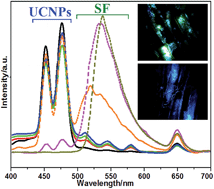Multicolor upconversion NaLuF4 fluorescent nanoprobe for plant cell imaging and detection of sodium fluorescein
Abstract
Multicolor upconversion NaLuF4 nanocrystals with strong upconversion luminescence and biocompatibility were synthesized by a general solvothermal method and subsequent surface modification. The emission color of these NaLuF4 upconversion nanoparticles can be easily modulated by the doping. These multicolor NaLuF4 upconversion nanocrystals can be employed as fluorescent probes for in vivo biological imaging for living beings, without the need of a slicing process. Importantly, the upconversion nanoprobes (UCNPs) with an acidic ligand can quickly capture the basic sodium fluorescein (SF) in plant cells and form a close UCNPs@SF system. The UCNPs@SF system can emit cyan light due to luminescence resonant energy transfer (LRET) from UCNPs to SF under the excitation of 980 nm infrared light, which is actually composed of the blue emission of NaLuF4:18%Yb3+/0.5%Tm3+ nanoprobes and the green emission of SF. According to the Integral Intensity Ratio of Green to Blue fluorescent signals (IIRGB), the concentration of SF can be easily addressed. The detection limit of sodium fluorescein for this upconversion fluorescent nanoprobe can reach upto 0.14 μg cm−3 in plant cells.


 Please wait while we load your content...
Please wait while we load your content...